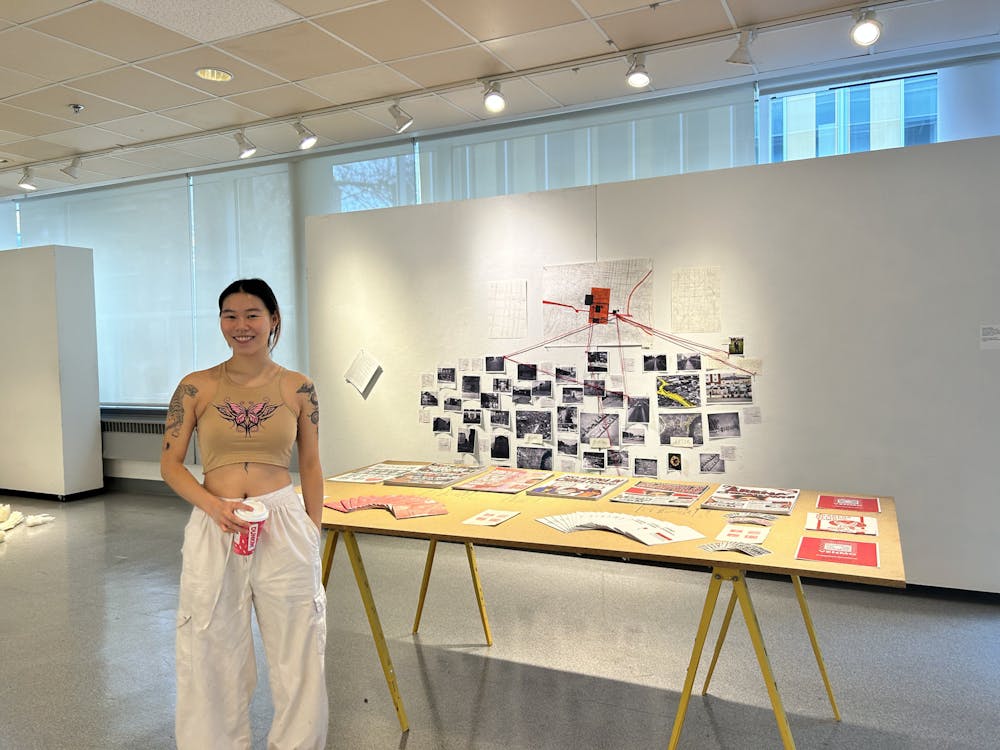If you’ve ever seen a Save Chinatown Flyer or the UC Townhomes sweatshirts, you’re looking at the art of Alyssa Chandler (C ‘24). Leaning on a couch in the Charles Addams Fine Arts Hall, Alyssa takes a sip of her Dunkin coffee. “It’s been a crazy week,” she admits, gesturing towards her senior thesis sitting on display as part of the Fine Arts Department as part of their Senior Thesis Preview Exhibition. On a table, Alyssa has laid out protest stickers and a hand–printed zine detailing the community’s current fight against the 76ers arena. On either side of the wall are archival photos and articles underscoring the history of Chinatown, including a handmade map of the Vine Street Expressway.
The project is a labor of love for Philly’s Chinatown and the Movement working to preserve it. In a world where the art gallery can feel ephemeral and detached, Alyssa’s work is rooted concretely in lived experience and community organizing. While her art might be displayed in a gallery now, it’s been on exhibition long before—taped in storefront windows across Philly, worn by students on their way to class, and held up high in the air in protests.
Name: Alyssa Chandler
Home State: Pennsylvania
Major: Fine Arts with a minor in English, Asian American Studies, and Cinema and Media Studies
Activities: Students for the Preservation of Chinatown (SPOC), Save the UC Townhomes
How did you first get involved in art? And when did your art meet activism?
I've always really liked art actually. My sister, who's four years older, she was really really into art as a young kid and, being a younger sibling, I just wanted to do whatever she did. So I started also drawing and painting, and I took art classes all through high school, which was really great. I think back then, my art was very much focused on like the intersection of art and humanities and social practices, but I wasn't able to really implement it into actions the way that I have been able to at my time at Penn. Having other resources and being in Philly and being a community member and really actually engaging with the community and other orgs has been fantastic.
I also did art and work for the UC Townhomes Coalition. Both the SPOC and the Townhomes work that I was doing was very much mobilized by trying to use whatever skills and tools I had—especially allocating resources from Penn directly into these communities that are being very much destroyed by people who have strong ties to Penn. So I started off doing a lot of screen printing, making posters making things to distribute, and flyers and art to support the cause and to supplement the cause.
Can you talk a little bit about your current projects and the work you’re doing with SPOC?
So, we just received a grant and, along with four other students, we're all working on individual art–based projects. So there's an oral archive that's being made, both through text and video. We're working to try to get a physical space. A storefront in Chinatown to organize out of that will hopefully serve as both kind of a screenprinting shop and then also just a spot to hang especially for Chinatown youth because right now the only spots that they're able to really congregate are in our churches and daycares which is not a vibe and not what they deserve.
And then the project that I'm spearheading is trying to make a mural in Chinatown, across from the current fashion district where the 76ers arena is being built. I'm still very much in the beginning stages of that design planning, but it's a lot of work. I've never been in charge of an official plan proposal and things like that. So it's been exciting to get to learn about the process and do what I want to do for the rest of my life.
What role do you see art playing in activism?
Art, it's a really powerful format. The legacy of protest art is just incredible and very inspiring. Protest art has been used around the world. I took a class called “Radical Arts in the Americas” (Now called, “Art and Revolution”) and we talked a lot about South American and Latinx protest artists and art, which has been really cool to learn more about.
But I think in terms of my immediate work, art serves both in function and in practice as an amazing community-building activity. I think community build and community art days are essential to really creating a movement around an action. Especially with the SPOC work and with the No Arena in Chinatown work that we've been doing, art has been really essential in creating posters and flyers and information booklets to hand out and distribute.
Alongside that we did a really fun print day for the Mid–Autumn Festival in Chinatown, where we printed a shit ton—I don't remember how many—but a bunch of t–shirts and totes and distributed them for free to the community. That was just so incredible getting to work with elders and youth and see the immediate impact and joy that art really brings to the community—and also brings outside of the community to people who are just passing by or coming to the Mid–Autumn Festival.
I think art is just overall a really great and powerful vehicle to further empower and push the movement further.
How are you utilizing Penn’s resources to help communities that Penn has historically overlooked?
For my senior thesis, I worked on a risograph zine which is really, really fun to print. And it has all the information about who we are as SPOC and as a larger extension of representing the community and what we're fighting for, who we're fighting, what the proposal and timeline for the arena is, and some of the prior legacy of development in Philadelphia's Chinatown and then other cities, Chinatown's across the nation. Getting to print this risograph zine on Penn's risograph printer was really fun because I would have no way to be able to do that outside of Penn's campus and not having to pay for the printing is also really sick.

Also my major art advisor—enough shout out Matt Neff. He's agreed to give us the old screen printing exposure unit, which is really expensive and really big and really hard to be able to fundraise especially because most of our funding before we got the grant was just through organizing with grassroots funding and donations. So it’s super empowering to be able to directly have artmaking machines and printers and resources for all of this. Also, shout out to the Morgan Building. I think I've stolen a bunch of stuff from there to use for like paper and screen printing. Even the screen that we've been printing the SPOC stuff on is from Penn. So I’ve just been taking all of the resources that I can have—legally and probably not legally—to further the movement and use that to supplement things. It's been great.
Can you speak a little bit to your community here at Penn, and how that has influenced in your last four years here on campus?
I think that overall, Penn is a really hard place to be at. All the places that I find the most powerful and beautiful and inspiring are usually with the friends I've made off campus and with my friends outside of the Penn bubble. So my housemates are the best people. They're my family; they're my sisters. I think the fact that we're all coming from different places and teaching and learning so much from each other has been essential. We talk a lot and expand things outside of not just West Philly, but the greater America which I think is essential towards linking struggles that are happening here to struggles that are happening across the world. One of my best friends is Sudanese–American. Contextualizing all of the things that are happening right now in America and in Sudan is especially important if you're going to claim to be doing activist work. If you’re caring about one cause you have to care about all of them. Because otherwise, your work and your cause fall flat and it's just more of an ego thing than anything else.
Final words?
Follow the SPOC Philly Instagram. We will continue to post updates about our projects, about events, and different ways to show up. Just please, if you're a Penn student reading this learn more about Penn’s ties to this arena because the developers sit on the boards of Penn Medicine, the Penn board trustees, and the Wharton Board of Trustees. Learn more about Penn’s impact on West Philly and the Black Bottom. And really think critically about your role on this land overall. We’re on Lenape land and in an institution that has done a lot to the communities around it and communities across the world, so understanding that is very important.
Lightning Round:
No–skip album? CAPRISONGS by FKA twigs. “papi bones” and “oh my love” had been my favorites.
If you were a building on campus, which one would you be? I don't think I'd want to be building on campus, to be honest. All the art buildings have a lot of issues. Penn facility building admins, if you're listening, please help us with the black mold that's in the fifth floor of Duhring Wing.
Favorite spot to eat in Philly? For fast food and late–night food definitely Best China Inn. For more of a sit–down meal or just vibing I love Marakesh and Dahlak.
Favorite medium to work in? Screenprinting right now. I think being able to mass produce and turnout designs and really distribute them to people directly is so incredible.
There are two types of people on Penn’s campus, and they are…? People who are aware and people who are not aware.
And you are? Hopefully aware. I mean, it's a constant struggle you have to constantly be putting work into it which is why a lot of people on Penn's campus are not aware.
This article was edited and condensed for clarity.

